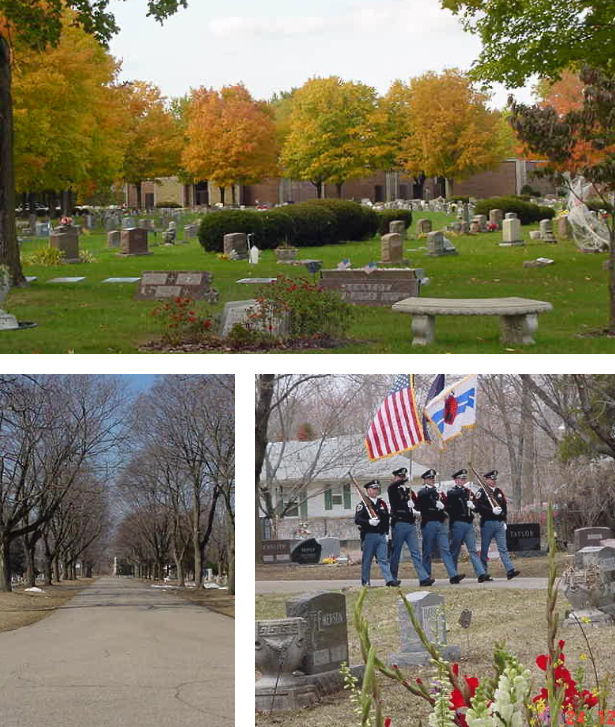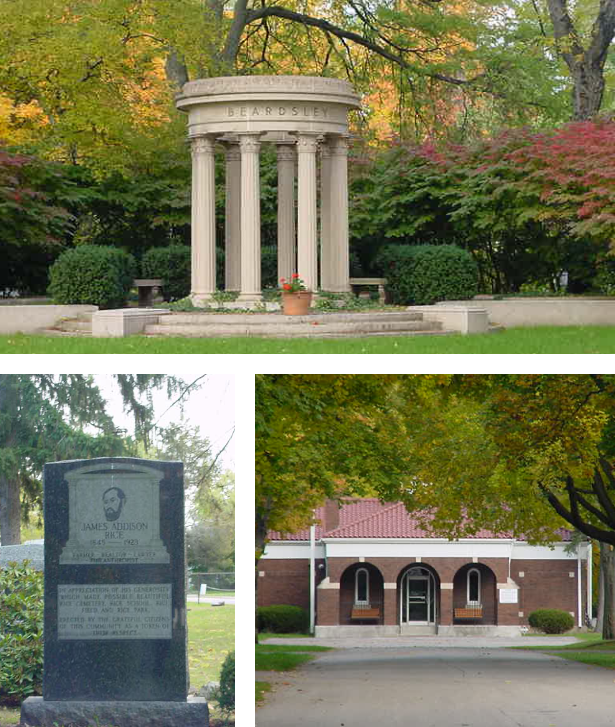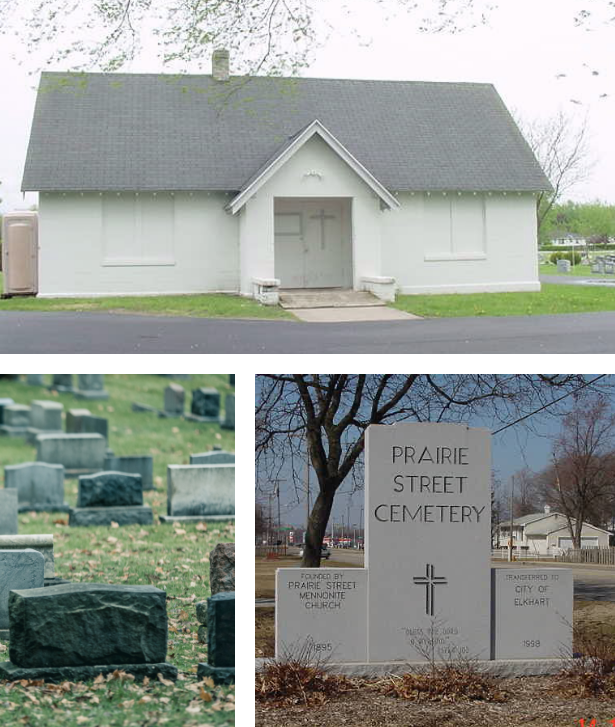Cemeteries.
 Cemeteries.
Cemeteries.
.
Welcome.
The staff at the Cemetery Department is responsible for all burials and entombments that take place in Rice, Grace Lawn and Prairie Street Cemeteries as well as the mowing, trimming and maintenance of the grounds.
We will assist the public with the selection of burial spaces, mausoleum crypts and niches for cremated remains for both at need and future need, as well as offering help in locating hard to find burials and genealogy requests.
Charlie Choate, Department Head charles.choate@coei.org
Hannah Colbourn, Administrative Assistant hannah.colbourn@coei.org
.
574-293-2811
.
574-293-4761

.
Welcome.
The staff at the Cemetery Department is responsible for all burials and entombments that take place in Rice, Grace Lawn and Prairie Street Cemeteries as well as the mowing, trimming and maintenance of the grounds.
We will assist the public with the selection of burial spaces, mausoleum crypts and niches for cremated remains for both at need and future need, as well as offering help in locating hard to find burials and genealogy requests.
Charlie Choate, Department Head charles.choate@coei.org
Hannah Colbourn, Administrative Assistant hannah.colbourn@coei.org
.
574-293-2811
.
574-293-4761

Rice
Cemetery.
.
.
 Rice Cemetery is the largest city cemetery in the city of Elkhart. As of December 31, 2000, there have been over 25,000 burials in the cemetery. Rice Cemetery is located at 400 James St. in Elkhart, Indiana. The property of which it is located on was deeded to the city of Elkhart on September 5, 1908 by James Addison Rice. As an only child of John Rice, he inherited the family farm consisting of approximately 90 acres from his father. His father had previously deeded land for Grace Lawn Cemetery in 1862.
Rice Cemetery is the largest city cemetery in the city of Elkhart. As of December 31, 2000, there have been over 25,000 burials in the cemetery. Rice Cemetery is located at 400 James St. in Elkhart, Indiana. The property of which it is located on was deeded to the city of Elkhart on September 5, 1908 by James Addison Rice. As an only child of John Rice, he inherited the family farm consisting of approximately 90 acres from his father. His father had previously deeded land for Grace Lawn Cemetery in 1862.
James Addison Rice was born on July 12, 1845 in Seneca County, New York. James and his family came to Elkhart in 1855. James’s father, John Rice, purchased the land mentioned above shortly after arriving in Elkhart. James left the Elkhart area to study law and the ministry at an Eastern college. He not only earned both degrees, but also received three gold medals for his scholastic abilities. He was a noted benefactor to many charitable projects. James Addison Rice was a bachelor and died at his residence, 427 Goshen Ave. on July 28, 1923. He is buried in Rice Cemetery where only a small stone inscribed James Addison Rice 1855-1923 marks his grave. In 1962, Frank Erb, Superintendent of Cemeteries, started a fund drive to erect an appropriate monument honoring the donor of the land for the cemetery as well as the other land he donated to the city. A seven foot high by three foot wide monument made of northern black granite, quarried in Canada, was unveiled on July 29, 1962. It is located just to the right of the entrance to Rice Cemetery (pictured on right). A circular flower bed surrounds the monument and the inscription reads: “James Addison Rice, 1845-1923, farmer, realtor, lawyer, philanthropist – in appreciation of his generosity which made possible beautiful Rice Cemetery, Rice School, Rice Field and Rice Park. Erected by the grateful citizens of this community as a token of their respect.”
The first burials in Rice Cemetery took place in 1913. Versa (Bessie) Koebernik was the first burial recorded on September 4, 1913. On the 11th of September, Jennie Ransier was buried. Obadiah Bore was buried December 31. There were four burials in 1914 and four burials in 1915.In 1921 a mortuary chapel and vault was built in the center of the cemetery (pictured on left). It is believed that this building was designed by E. Hill Turnock. This was eventually converted into the current sexton’s office and maintenance department. E. Hill Turnock designed the initial portion of the cemetery in 1918.
At the entrance to Rice Cemetery, just off James St. stands a 32 foot high monument (designed by Nelson P. Doty) in polished brass and white limestone with a pedestal of Bedford Indiana stone. A bronze statue of a Civil War Union infantry soldier, standing at parade rest, can be seen at the top. Carved at the base are the four Civil War battle names of Shiloh, Stone River, Atlanta and Appomattox.
Although Grace Lawn Cemetery in Elkhart has the distinction of having the youngest enlisted Civil War Union soldier (drummer boy, Avery Brown, age 8 years 11 months) buried in the cemetery, Rice Cemetery also has a young Union soldier buried in its cemetery. George Bickford Coleman, born April 22, 1852, joined the 13th New York volunteer regiment at the age of 9 years as a drummer boy. When his widowed mother found what her young son did, she went to the training camp and brought him back home. Two years later, at the age of 11, he again left home and joined the army as a bugler in the 21st New York Cavalry H Troop and was mustered out at the end of the war in 1865 (age 13). He died May 19, 1929.
In 1971, as Rice Cemetery began to fill up, the first mausoleum Chapel of Peace was built. The interior walls are of marble from Italy and the exterior walls are granite. The mausoleum has spaces for 756 interments and 48 niches. A second identical mausoleum Chapel of Memories was built later, and between the two are Hope and Faith having room for 264 outside interments.
* Historical facts provided by Patricia K. Johnson & Jeffrey L. Keim
GraceLawn
Cemetery.
.
.
 The first burial ground for the city of Elkhart was located at the corner of Middlebury and Prairie Streets and was established about the time Elkhart was platted in April 1832. By the early 1860’s, it became apparent that the cemetery would not be large enough to serve the growing population of Elkhart. At that time the city of Elkhart began negotiations to buy land for Grace Lawn Cemetery.
The first burial ground for the city of Elkhart was located at the corner of Middlebury and Prairie Streets and was established about the time Elkhart was platted in April 1832. By the early 1860’s, it became apparent that the cemetery would not be large enough to serve the growing population of Elkhart. At that time the city of Elkhart began negotiations to buy land for Grace Lawn Cemetery.
In 1855, John and Charles Rice of New York originally purchased 194.84 acres located in the Section 4 Township 37 Range 5, from Lorenzo Cody and his wife. Soon afterwards, John bought Charles’s half of the land. In 1862, John M. Rice, sold eight of these acres, located just east of the river, to the city of Elkhart to use as a cemetery.
In July 1867, John M. Rice sold 34.65 acres of his land to Eli Conley. In turn Eli Conley, sold part of this acreage to the city of Elkhart for the final portion that make up Grace Lawn Cemetery. Also making up that final portion of Grace Lawn, was acreage sold to the city of Elkhart by John C. and Ann P. Evans. This last portion purchased from Conley and Evans consisted of 5 acres.
John C. Evans (d. 1902) and Anna P. Straw, his wife (d. 1898), are buried in Block E Lot 14. Eli Conley (d. 1907) and Sarah A. (d. 1914), his wife, are buried in Block P Lot 113. They were both very active in the city of Elkhart. John Evans was a brick mason and built many of the brick structures in early Elkhart. The most notable structure was the Davenport residence which was later owned by G.B. Pratt. Eli Conley was in the real estate business and was one of the promoters of the Bucklen Opera House. It was mainly due to his efforts that the Opera House was built.
Charles Beardsley (a town trustee) surveyed the original plat for Grace Lawn, donating his service to the city. In return, the cemetery was named after his foster daughter Grace (Mrs. E.L. Clark). Both are buried in Grace Lawn.
The dedication of Grace Lawn Cemetery took place in 1864, which included the sale of lots at auction. After Grace Lawn was developed in 1864, many bodies from the old Middlebury street cemetery were removed by relatives to Grace Lawn Cemetery. The remainder of these bodies were removed in 1893 and buried in Block Q. Names of those moved are available at the Cemetery Office. Any stones readable are also listed.
Havilah Beardsley (1795-1856), the founder of Elkhart (having purchased the property in 1832 from Indiana Chief Pierre Moran) was among those bodies moved from the old cemetery. He was buried in the Rufus Beardsley family plot located in Block E Lot 29. Also moved from the old cemetery was George Claybourn, a freed slave from Virginia. George (born about 1785) was in Elkhart as early as 1843 and was listed in both the 1850 and 1860 Elkhart census. He died about 1869.
In 1918, a beautiful gateway into Grace Lawn Cemetery was built with funds provided by Mrs. Elizabeth Baldwin Beardsley (wife of the then deceased Albert R. Beardsley). Both are buried in the Baldwin-Beardsley mausoleum located in Block E. The gateway, as well as the Beardsley mausoleum, were designed by E. Hill Turnock.
It has been estimated that over 100 Civil War soldiers are buried in Grace Lawn Cemetery. Given the time this cemetery was formed, this is probably a very conservative estimate.
In 1947, there were 2,436 individual lot owners, with only a few lots remaining. The sexton’s books show 12,669 burials at the end of 1999; however, there are burials listed in the city book which are not recorded in the sexton’s book.
Grace Lawn is the burial place of many men who were instrumental in the building of early Elkhart. The unique monuments seen throughout Grace Lawn are many. Unfortunately, many were vandalized, destroyed or stolen over the years. The design and architecture of these monuments are outstanding and are readily seen throughout the cemetery.
* Historical facts provided by Patricia K. Johnson & Jeffrey L. Keim
Prairie St.
Cemetery.
.
.
 The Prairie Street Cemetery is a city-owned cemetery located on the south side of Elkhart. It is on Hively Avenue, with its entrance just east of Prairie Street.
The Prairie Street Cemetery is a city-owned cemetery located on the south side of Elkhart. It is on Hively Avenue, with its entrance just east of Prairie Street.
The original land (5 acres) for the Prairie Street Cemetery was sold to the Mennonite Church by the owner Lewis Kulp in January 1895. Additional property was purchased for the cemetery on March 12, 1928 from Anna Kulp Moyer and Jacob Moyer. This property is located just south of the original purchase and also consists of approximately 5 acres. On October 9, 1939, an additional 4.85 acres was obtained from Anna C. Moyer.
In March 1998, the Prairie Street Mennonite Church (owner of the Prairie Street Cemetery) donated the cemetery and any undevelooped land it owned adjacent to the cemetery at that time, to the city of Elkhart. It was estimated that there were over 9,000 burials already in the cemetery. Since the city of Elkhart has taken over the cemetery operations there have been an additional 1400 burials (through May 2008).
* Historical facts provided by Patricia K. Johnson & Jeffrey L. Keim
Rice
Cemetery.
.
.
 Rice Cemetery is the largest city cemetery in the city of Elkhart. As of December 31, 2000, there have been over 25,000 burials in the cemetery. Rice Cemetery is located at 400 James St. in Elkhart, Indiana. The property of which it is located on was deeded to the city of Elkhart on September 5, 1908 by James Addison Rice. As an only child of John Rice, he inherited the family farm consisting of approximately 90 acres from his father. His father had previously deeded land for Grace Lawn Cemetery in 1862.
Rice Cemetery is the largest city cemetery in the city of Elkhart. As of December 31, 2000, there have been over 25,000 burials in the cemetery. Rice Cemetery is located at 400 James St. in Elkhart, Indiana. The property of which it is located on was deeded to the city of Elkhart on September 5, 1908 by James Addison Rice. As an only child of John Rice, he inherited the family farm consisting of approximately 90 acres from his father. His father had previously deeded land for Grace Lawn Cemetery in 1862.
James Addison Rice was born on July 12, 1845 in Seneca County, New York. James and his family came to Elkhart in 1855. James’s father, John Rice, purchased the land mentioned above shortly after arriving in Elkhart. James left the Elkhart area to study law and the ministry at an Eastern college. He not only earned both degrees, but also received three gold medals for his scholastic abilities. He was a noted benefactor to many charitable projects. James Addison Rice was a bachelor and died at his residence, 427 Goshen Ave. on July 28, 1923. He is buried in Rice Cemetery where only a small stone inscribed James Addison Rice 1855-1923 marks his grave. In 1962, Frank Erb, Superintendent of Cemeteries, started a fund drive to erect an appropriate monument honoring the donor of the land for the cemetery as well as the other land he donated to the city. A seven foot high by three foot wide monument made of northern black granite, quarried in Canada, was unveiled on July 29, 1962. It is located just to the right of the entrance to Rice Cemetery (pictured on right). A circular flower bed surrounds the monument and the inscription reads: “James Addison Rice, 1845-1923, farmer, realtor, lawyer, philanthropist – in appreciation of his generosity which made possible beautiful Rice Cemetery, Rice School, Rice Field and Rice Park. Erected by the grateful citizens of this community as a token of their respect.”
The first burials in Rice Cemetery took place in 1913. Versa (Bessie) Koebernik was the first burial recorded on September 4, 1913. On the 11th of September, Jennie Ransier was buried. Obadiah Bore was buried December 31. There were four burials in 1914 and four burials in 1915.In 1921 a mortuary chapel and vault was built in the center of the cemetery (pictured on left). It is believed that this building was designed by E. Hill Turnock. This was eventually converted into the current sexton’s office and maintenance department. E. Hill Turnock designed the initial portion of the cemetery in 1918.
At the entrance to Rice Cemetery, just off James St. stands a 32 foot high monument (designed by Nelson P. Doty) in polished brass and white limestone with a pedestal of Bedford Indiana stone. A bronze statue of a Civil War Union infantry soldier, standing at parade rest, can be seen at the top. Carved at the base are the four Civil War battle names of Shiloh, Stone River, Atlanta and Appomattox.
Although Grace Lawn Cemetery in Elkhart has the distinction of having the youngest enlisted Civil War Union soldier (drummer boy, Avery Brown, age 8 years 11 months) buried in the cemetery, Rice Cemetery also has a young Union soldier buried in its cemetery. George Bickford Coleman, born April 22, 1852, joined the 13th New York volunteer regiment at the age of 9 years as a drummer boy. When his widowed mother found what her young son did, she went to the training camp and brought him back home. Two years later, at the age of 11, he again left home and joined the army as a bugler in the 21st New York Cavalry H Troop and was mustered out at the end of the war in 1865 (age 13). He died May 19, 1929.
In 1971, as Rice Cemetery began to fill up, the first mausoleum Chapel of Peace was built. The interior walls are of marble from Italy and the exterior walls are granite. The mausoleum has spaces for 756 interments and 48 niches. A second identical mausoleum Chapel of Memories was built later, and between the two are Hope and Faith having room for 264 outside interments.
* Historical facts provided by Patricia K. Johnson & Jeffrey L. Keim
GraceLawn
Cemetery.
.
.
 The first burial ground for the city of Elkhart was located at the corner of Middlebury and Prairie Streets and was established about the time Elkhart was platted in April 1832. By the early 1860’s, it became apparent that the cemetery would not be large enough to serve the growing population of Elkhart. At that time the city of Elkhart began negotiations to buy land for Grace Lawn Cemetery.
The first burial ground for the city of Elkhart was located at the corner of Middlebury and Prairie Streets and was established about the time Elkhart was platted in April 1832. By the early 1860’s, it became apparent that the cemetery would not be large enough to serve the growing population of Elkhart. At that time the city of Elkhart began negotiations to buy land for Grace Lawn Cemetery.
In 1855, John and Charles Rice of New York originally purchased 194.84 acres located in the Section 4 Township 37 Range 5, from Lorenzo Cody and his wife. Soon afterwards, John bought Charles’s half of the land. In 1862, John M. Rice, sold eight of these acres, located just east of the river, to the city of Elkhart to use as a cemetery.
In July 1867, John M. Rice sold 34.65 acres of his land to Eli Conley. In turn Eli Conley, sold part of this acreage to the city of Elkhart for the final portion that make up Grace Lawn Cemetery. Also making up that final portion of Grace Lawn, was acreage sold to the city of Elkhart by John C. and Ann P. Evans. This last portion purchased from Conley and Evans consisted of 5 acres.
John C. Evans (d. 1902) and Anna P. Straw, his wife (d. 1898), are buried in Block E Lot 14. Eli Conley (d. 1907) and Sarah A. (d. 1914), his wife, are buried in Block P Lot 113. They were both very active in the city of Elkhart. John Evans was a brick mason and built many of the brick structures in early Elkhart. The most notable structure was the Davenport residence which was later owned by G.B. Pratt. Eli Conley was in the real estate business and was one of the promoters of the Bucklen Opera House. It was mainly due to his efforts that the Opera House was built.
Charles Beardsley (a town trustee) surveyed the original plat for Grace Lawn, donating his service to the city. In return, the cemetery was named after his foster daughter Grace (Mrs. E.L. Clark). Both are buried in Grace Lawn.
The dedication of Grace Lawn Cemetery took place in 1864, which included the sale of lots at auction. After Grace Lawn was developed in 1864, many bodies from the old Middlebury street cemetery were removed by relatives to Grace Lawn Cemetery. The remainder of these bodies were removed in 1893 and buried in Block Q. Names of those moved are available at the Cemetery Office. Any stones readable are also listed.
Havilah Beardsley (1795-1856), the founder of Elkhart (having purchased the property in 1832 from Indiana Chief Pierre Moran) was among those bodies moved from the old cemetery. He was buried in the Rufus Beardsley family plot located in Block E Lot 29. Also moved from the old cemetery was George Claybourn, a freed slave from Virginia. George (born about 1785) was in Elkhart as early as 1843 and was listed in both the 1850 and 1860 Elkhart census. He died about 1869.
In 1918, a beautiful gateway into Grace Lawn Cemetery was built with funds provided by Mrs. Elizabeth Baldwin Beardsley (wife of the then deceased Albert R. Beardsley). Both are buried in the Baldwin-Beardsley mausoleum located in Block E. The gateway, as well as the Beardsley mausoleum, were designed by E. Hill Turnock.
It has been estimated that over 100 Civil War soldiers are buried in Grace Lawn Cemetery. Given the time this cemetery was formed, this is probably a very conservative estimate.
In 1947, there were 2,436 individual lot owners, with only a few lots remaining. The sexton’s books show 12,669 burials at the end of 1999; however, there are burials listed in the city book which are not recorded in the sexton’s book.
Grace Lawn is the burial place of many men who were instrumental in the building of early Elkhart. The unique monuments seen throughout Grace Lawn are many. Unfortunately, many were vandalized, destroyed or stolen over the years. The design and architecture of these monuments are outstanding and are readily seen throughout the cemetery.
* Historical facts provided by Patricia K. Johnson & Jeffrey L. Keim
Prairie St.
Cemetery.
.
.
 The Prairie Street Cemetery is a city-owned cemetery located on the south side of Elkhart. It is on Hively Avenue, with its entrance just east of Prairie Street.
The Prairie Street Cemetery is a city-owned cemetery located on the south side of Elkhart. It is on Hively Avenue, with its entrance just east of Prairie Street.
The original land (5 acres) for the Prairie Street Cemetery was sold to the Mennonite Church by the owner Lewis Kulp in January 1895. Additional property was purchased for the cemetery on March 12, 1928 from Anna Kulp Moyer and Jacob Moyer. This property is located just south of the original purchase and also consists of approximately 5 acres. On October 9, 1939, an additional 4.85 acres was obtained from Anna C. Moyer.
In March 1998, the Prairie Street Mennonite Church (owner of the Prairie Street Cemetery) donated the cemetery and any undevelooped land it owned adjacent to the cemetery at that time, to the city of Elkhart. It was estimated that there were over 9,000 burials already in the cemetery. Since the city of Elkhart has taken over the cemetery operations there have been an additional 1400 burials (through May 2008).
* Historical facts provided by Patricia K. Johnson & Jeffrey L. Keim

